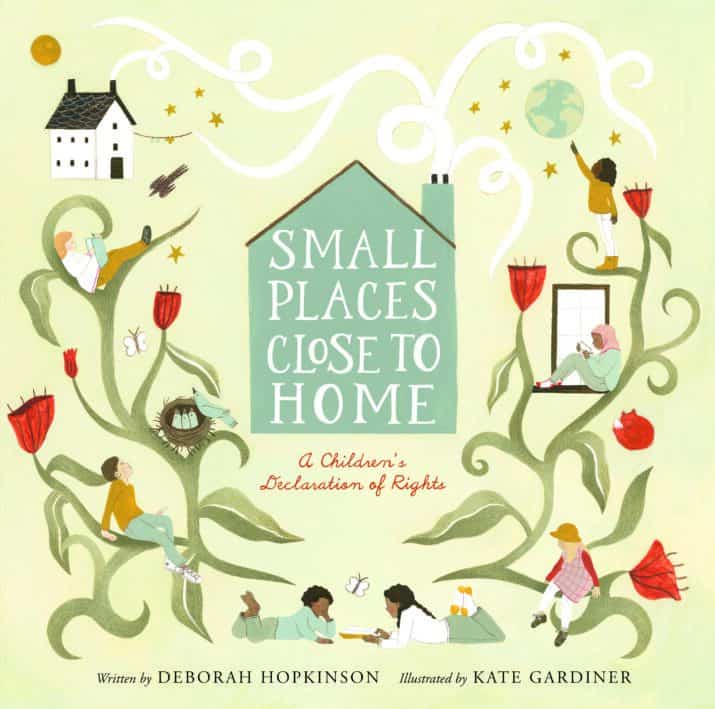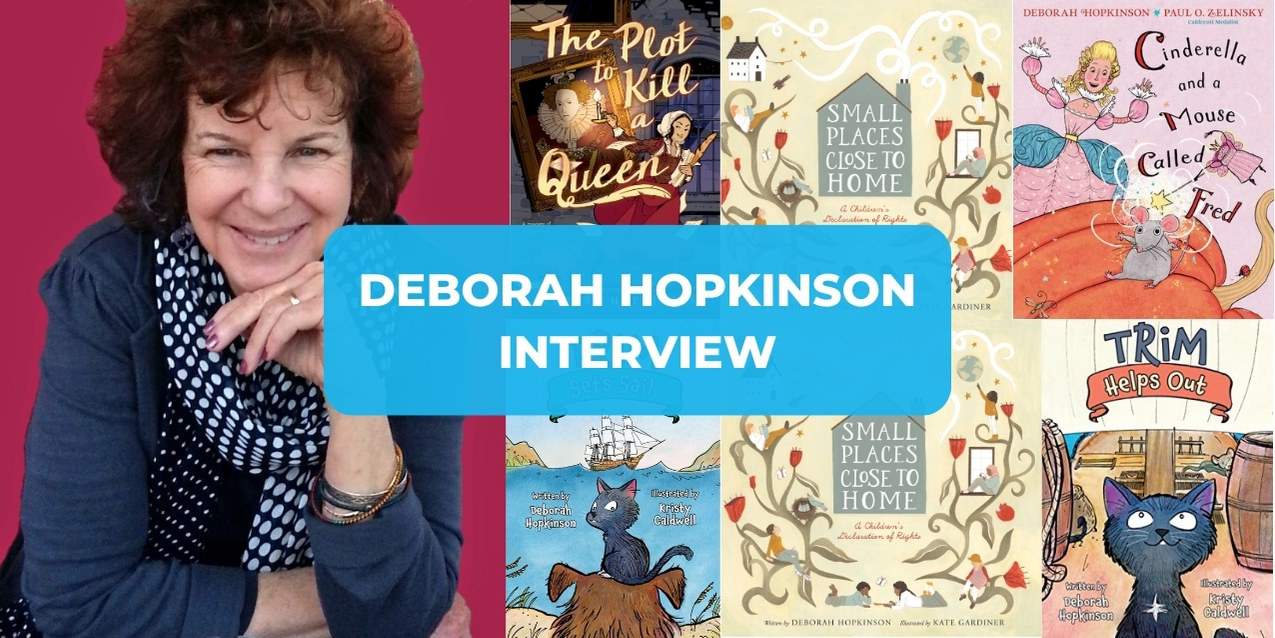Prolific children’s book writer Deborah Hopkinson continues to publish children’s books for all levels of readers in different genres, including both fiction and nonfiction. She’s thrilled about her five, yes, five books releasing this fall of 2023. And I’m thrilled to interview her about her work and these new books.
ABOUT DEBORAH HOPKINSON

A native of Lowell, Massachusetts, Deborah Hopkinson’s more than 70 children’s books include picture books, middle-grade historical fiction, Little Golden Book biographies, and long-form nonfiction. Her titles have won the Oregon Book Award, the SCBWI Golden Kite Award for Picture Book Text, the Jane Addams Children’s Book Award, and the Green Earth Environmental Award. Other awards include a Sibert honor, a Carter G. Woodson honor, NCTE Orbis Pictus Honor, and Boston Globe/Horn Book honor. Deborah received a B.A. and a master’s degree from the University of Hawai’i at Mānoa and worked in academic advancement prior to writing full time. Deborah currently lives in Oregon.
Author Interview with Deborah Hopkinson
MELISSA: How do you hope adults will use SMALL PLACES, CLOSE TO HOME with children?

DEBORAH: We chose Fall 2023 for the publication of Small Places, Close to Home, A Children’s Declaration of Rights illustrated by Kate Gardiner, because December 2023 marks the 75th anniversary of the Universal Declaration of Human Rights, first shepherded through the United Nations by Eleanor Roosevelt.
The text is divided into three sections: Me. My School and Community, and My Country and World, and we hope parents, grandparents, and educators will want to use the book as a springboard for lots of discussions, not only about human rights issues globally, but also about our responsibilities to one another, whether it’s a first grader learning to be patient on the playground or a middle schooler wondering how to respond to bullying. I hope it will inspire young readers to write and illustrate their own versions.
MELISSA: TRIM SETS SAIL is sure to enchant readers. How did you discover this historical cat, and what kinds of adventures can we expect next in the series?

DEBORAH: I can’t recall when or how I first discovered that British explorer Matthew Flinders (1774-1814), credited with the first circumnavigation expedition around Australia, had written a wonderful tribute to his beloved cat, Trim.
I spent several years trying to figure out how to make this into a story, and it wasn’t quite working as a picture book. The Adventures of Trim series is my first venture into an intermediate reader or very short chapter book and it’s been a real pleasure to see Kristy Caldwell’s absolutely delightful illustrations of Trim and the crew.
Trim Sets Sail and Trim Helps Out publish in Fall 2023, while Trim Saves the Day and Trim Sails the Storm come out in 2024. I’m especially excited to write for this young audience and to introduce them to the genre of historical fiction through the books. While the non-human characters (Trim, along with ship’s dog Penny, a grouchy parrot named Jack, and a rat called Princess Bea) take center stage, both Kristy and I have researched details of the HMS Investigator.
As for Trim’s adventures, while some are totally made-up, I have also drawn from Flinders’s warm-hearted and surprisingly modern-sounding tribute to Trim, in which he describes some of Trim learning to swim as a kitten and swiping tasty morsels off the forks of sailors at mealtimes. I hope the series is as much fun to read as it has been to write!
MELISSA: Why Cinderella? What was the motivation for writing CINDERELLA AND A MOUSE CALLED FRED? And what are you hoping for this book in the world?

DEBORAH: If I’m not sitting at my desk, I’m out in my garden. One of my favorite Cinderella adaptations is Ever After with Drew Barrymore, in part because we see Cinderella in a French pastoral setting, growing apples and harvesting produce from the garden. And when I came across a kind of French heirloom pumpkin nicknamed “fairytale pumpkins,” I decided to try my hand at my first talking animal picture book. (I began working on this story before the Trim books.) And I was thrilled when editor Anne Schwartz told me that Caldecott medalist Paul O. Zelinsky had agreed to illustrate the book!
Ella finds her own destiny in this version of the tale, falling in love with a young woman who also loves farming and gardens. One (rather unpleasant) surprise is the intensity of the pushback I’ve encountered. Although I agreed not to present about the book, I’ve had invitations to schools and a library festival rescinded this fall because hosts have feared protests.
I have had other books be questioned or banned, but never been disinvited from an event before. It’s disheartening but also a bit ironic that my first talking animal book (with a mouse of all things!) should be considered so very dangerous.
MELISSA: Your middle grade books always are exceptionally written and THE PLOT TO KILL A QUEEN is no different. How much research did you do before you started writing? And how did you go about finding the charming narrative voice of Emilia? (For example, is this something that you write and rewrite or does it just come to you?)

DEBORAH: Thank you! I have to say that The Plot to Kill a Queen, which takes place in 1582 in Elizabethan England, is perhaps the book closest to my heart. Or, at least, I was a girl who longed to write, and I also would have loved to be sent on a spy mission to a creepy old castle where Mary, Queen of Scots is being held prisoner. One of my favorite books, as early as middle school, was Jane Eyre, and there’s something irresistible about the idea of a journey to a new and rather mysterious place.
I’d written about Tudor England before, as one of the authors of Fatal Throne: The Wives of Henry VIII Tell All. My role was Katherine Parr (the sixth wife), who served as stepmother to the future Queen Elizabeth. My daughter, Rebekah, also did a lot of theatre as a girl. And, in fact, one of my first professional jobs was marketing director for the Manoa Valley Theater in Honolulu.
Of course, I also read a ton of secondary sources for help with the details of Elizabethan life, including dress, food, and customs. I was also aided by the fact that scholars of Mary, Queen of Scots have dug up a surprising amount of details about her household and the meals they ate.
As for Emilia’s voice, it definitely required lots of rewriting. As for inspiration for her canine companion, Mouse, I just had to look over at Little Rue, my snoozing spaniel right next to me. This is Rue’s second appearance in one of my novels: She appeared as Little Roo in How I Became a Spy, which takes place in 1944 London. Quite a time traveler!
MELISSA: For those of us who are also writers, can you tell us more about your writing process?
DEBORAH: I haven’t always been a full-time author, and spent many years working in academic fundraising writing grants and planning galas and special events. So I definitely understand how difficult it is to get started and to maintain momentum while also trying to work, raise kids, or simply keep a household running.
For that reason, I don’t believe that what works for one person will work for someone else. I couldn’t write every day while in a demanding job and raising two kids. But you do the best you can.
Since most of my books (even Cinderella has a historical note) do involve considerable research. My long-form nonfiction titles, including Race Against Death: The Greatest POW Rescue of World War II, usually start with several weeks of photograph research, and I find that helps shape my narrative. I also mine oral history collections at libraries and museums, and dig into the source notes and bibliographies of secondary sources.
I find writing fiction more challenging than nonfiction, but no matter what I write, I revise it multiple times before even showing it to an editor. I’m a firm believer that writing gets better. I mean, if it worked for Jane Austen, who are we to expect anything different?


 PARENTING TIPS
PARENTING TIPS PREGNANCY
PREGNANCY BABY CARE
BABY CARE TODDLERS
TODDLERS TEENS
TEENS HEALTH CARE
HEALTH CARE ACTIVITIES & CRAFTS
ACTIVITIES & CRAFTS


